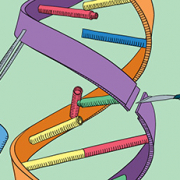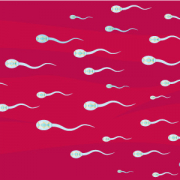What is genomic imprinting?
We explore one type of epigenetic modification, its function in our genome and the rare conditions that have been linked to it
Rare diseases can be caused by a variety of factors. Many occur because of alterations to the DNA sequence itself, but some can be caused by epigenetic modifications: in other words, changes in gene expression. Genomic imprinting is one such modification that affects the regulation of certain genes, but how can it cause disease?
Epigenetic modifications
Epigenetics, literally ‘on top of genomics’, is the study of changes to phenotype that are not caused by alterations to the DNA sequence. Instead, these changes happen because our genes are turned ‘on’ and ‘off’ by various mechanisms. This switching on and off is very common, and indeed is an important part of normal, healthy gene regulation. However, if this regulation is disrupted, it can lead to certain genes being over or under expressed, or silenced completely.
Although many of our genes are affected by epigenetic modifications, only a very small percentage are known to undergo genomic imprinting. These genes are mostly found in two clusters – one on the short arm of chromosome 11 and the other on the long arm of chromosome 15.
How genomic imprinting works
Genomic imprinting refers to the process by which certain genes are ‘branded’ with the parent of origin. When gametes (sperm and eggs) are made, epigenetic markers that were inherited from our parents or accumulated in life are removed, but in genes that undergo genomic imprinting, new markers are added that identify the gene as coming from either the mother or the father.
These new markers change gene expression, resulting in the imprinted copy of the gene being turned off and the other copy being turned on. For example, if the allele inherited from the father is imprinted, it is silenced and only the allele from the mother is expressed; if the allele from the mother is imprinted, then only the allele from the father is expressed.
Uniparental disomy
Genomic imprinting can cause disease when there are errors in gamete production, or during early embryonic development. One common complication is uniparental disomy (UPD), which is when a person inherits two copies of a chromosome from one parent, and none from the other.
When the chromosome in question does not contain imprinted regions, UPD may have no deleterious effects, but when chromosomes 11 or 15 are involved, the situation can be more complex. Because some genes in these regions are inactivated by maternal or paternal imprinting, an individual who inherits two copies from one parent can lack an active copy of some essential genes – even though they are present in the genome.
Which conditions can it cause?
The first conditions that were identified as being caused by imprinting were Angelman Syndrome and Prader-Willi Syndrome. Both conditions are caused by missing genetic information on chromosome 15 – one of the chromosomes where genomic imprinting is common.
Angelman syndrome occurs when the UBE3A gene is not working properly or is missing entirely. The paternal copy of the gene is imprinted, or silenced, meaning that only the copy inherited from the person’s mother is active. Problems with or deletion of the maternal copy of the gene, or the section of chromosome 15 where it resides, can lead to Angelman syndrome.
In Prader-Willi syndrome (PWS), the same region of chromosome 15 is involved. In this case, though, the condition is linked to problems with the paternal copy of the chromosome rather than the maternal copy. Certain genes in the region, such as SNRPN, are imprinted, with the maternal copy being silenced and the paternal copy being active. Problems with the paternal copies of these genes can lead to PWS.
Most cases of Angelman syndrome and PWS are caused by deletions, although a significant minority are due to UPD.
Another condition linked to genomic imprinting is Beckwith-Wiedemann syndrome (BWS). It is caused by changes to imprinted genes in the chromosome 11 cluster, with a number of genes being implicated thus far, including H19 and IGF2. It is associated with abnormal growth and an increased chance of childhood cancers, especially in the liver and kidneys.
Scientists hope that continued research into the genetic pathways involved in BWS will help to improve treatment methods and outcomes for those with the condition.
Want to learn more about the complex role of gene regulation in disease? Our article on epigenetics is available in our blog.
–








